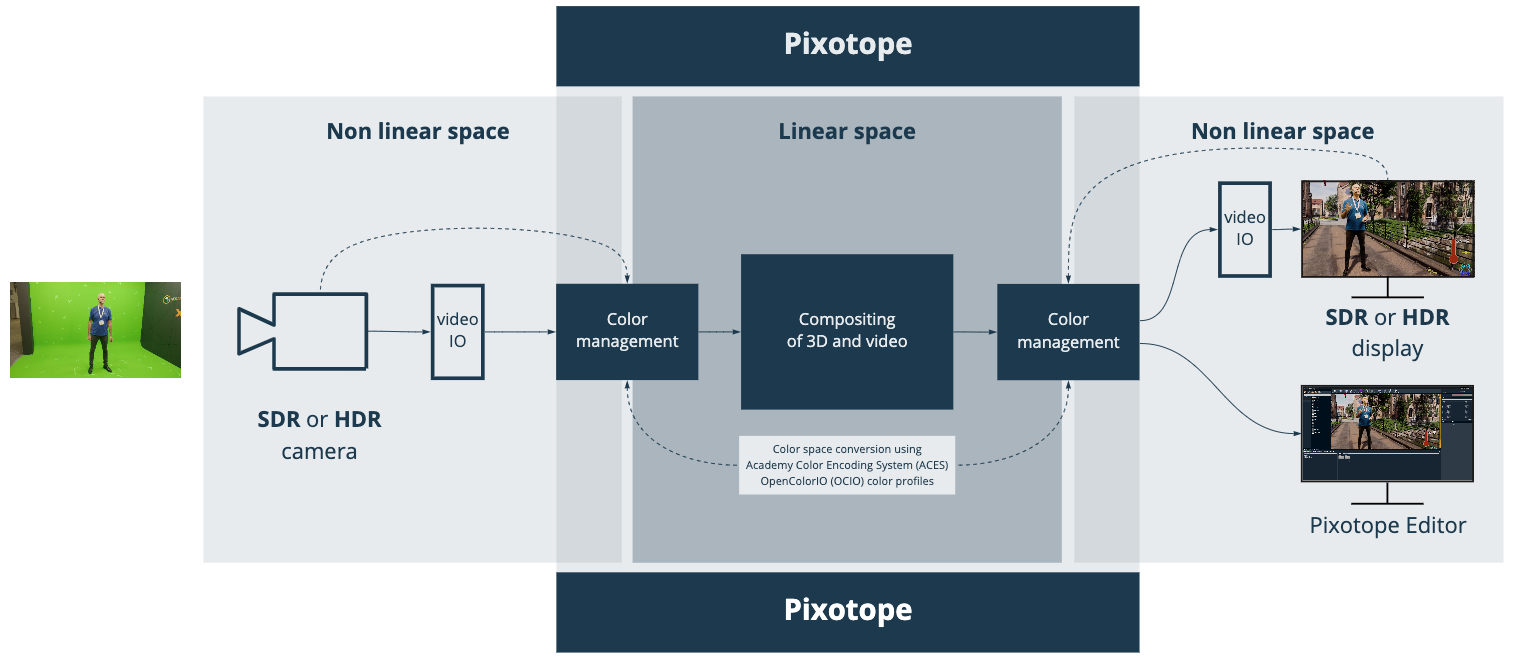HDR and color management
HDR
Introduction
High-dynamic-range video (HDR video) describes video having a dynamic range greater than that of standard-dynamic-range video (SDR video). HDR video involves capture, production, content/encoding and display. HDR capture and displays are capable of much brighter whites and an overall much higher contrast ratio. To accommodate this, HDR encoding standards allow for a higher maximum luminance and use at least a 10-bit dynamic range (compared to 8-bit for non-professional and 10-bit for professional SDR video) in order to maintain precision across this extended range.
While technically "HDR" refers strictly to the ratio between the maximum and minimum luminance, the term "HDR video" is commonly understood to imply wide color gamut (WCG) as well.
The goal
The goal of HDR (high-dynamic-range) and WCG (wide color gamut) is to:
increase image quality
achieve more natural looking images
approach towards photorealism
Additionally, it allows for:
linear compositing, which greatly enhances realism when combining graphics and video
Learn more about Compositing color space and Linear space compositing
HDR workflow
HDR requires:
an HDR camera
to capture many more f-stops in a single exposure than a traditional video camera (greater dynamic range)
an HDR-ready transportation medium
to ensure optimal bandwidth and compatibility without losing extra information captured by HDR cameras
an HDR-ready color management system
to ensure that the captured light information is interpreted, processed and encoded in a predictable and correct way
an HDR display
to show brighter highlights without compromising shadows and details
it is not possible to judge what you cannot see accurately
HDR-ready color management
To ensure that HDR video is interpreted, processed and encoded in a predictable and correct way, the HDR-ready color management system needs to deliver:
control of color gamut encoding
control of quantization/bit depth
control of gamma and dynamic range encoding
For each step in the HDR workflow, there are many flavors of encoding, for cameras, media and displays, that the color management system brings together.
Color management in Pixotope
Pixotope provides an HDR-ready color management system to allow for a complete HDR workflow.
Our working color space is ACEScg, which is a linear color space that suits all sorts of high dynamic range and wide color gamut pictures.

Our color management system is based on two open-source color management initiatives:
Academy Color Encoding System (ACES)
OpenColorIO (OCIO)
ACES
ACES, or the Academy Color Encoding System, is an open color management and interchange system developed by the Academy of Motion Picture Arts and Sciences (AMPAS) and industry partners. It:
standardizes the color science used in projects of all types
gives the industry a standardized color management system that encompasses:
production
post-production
presentation
archiving
In an industry with dozens of different camera systems, multiple encoding options, different display devices, etc., the Academy saw a need for a system like ACES to manage color in a precise yet straightforward way, no matter the camera or display being used.
Many software developers have tackled color management in their own applications, but none of those solutions are industry-wide and open. ACES is an industry-standard color management solution that anyone can use to manage the color pipeline of any project.
Learn more about → ACES or see their → documentation.
Pixotope uses a version of ACES 1.1 implemented for OpenColorIO.
OCIO
OpenColorIO (OCIO) is a complete color management solution geared towards television and motion picture production with an emphasis on visual effects and computer graphics. OCIO provides a straightforward and consistent user experience across all supporting applications while allowing for sophisticated back-end configuration options suitable for high-end production usage. OCIO is compatible with the Academy Color Encoding Specification (ACES) and is LUT-format agnostic, supporting many popular formats.
OCIO is fully user-configurable, and all color management knowledge resides in the color transforms and human-readable configuration files.
Pixotope currently supports the OCIO 2.0 implementation.
Learn more about → OpenColorIO.
Pixotope ships with a custom version of the ACES 1.1 OpenColorIO configuration: https://github.com/colour-science/OpenColorIO-Configs/tree/feature/aces-1.1-config/aces_1.1
How to create custom color transforms and profiles
If you need to create custom color transforms, this online tool can create OCIO-compatible Look Up Tables (spi1d, spi3d): https://cameramanben.github.io/LUTCalc/LUTCalc/index.html
How to add custom color profiles
We currently support OpenColorIO:
Create an OpenColorIO LUT
Example files here: https://github.com/imageworks/OpenColorIO-ConfigsPlace the file in
CODE[Your installation path]\Services\VideoIO\ocio-configs\aces_1.1\lutsAdd your color space/LUT to the
config.ociofileCODE[Your installation path]\Services\VideoIO\ocio-configs\aces_1.1
Switch panels to update the available color profiles
Learn more about → OpenColorIO
